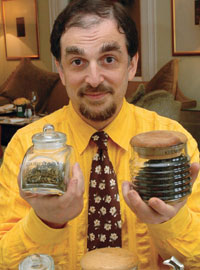


 Tea Sommelier
Tea Sommelier
Chai, garam chai! In Mumbai, although we drink tea all the time it's boringly basic: the 'cutting chai' that canteen boys in newspaper offices pass around in small, squat glasses (never very well washed); the malodorous 'masala chai', redolent with ginger and sticky sweet cardamoms; the Parsi 'fudna choy' (made with fresh lemon grass and mint sprigs) and served with small butter biscuits called 'batasas' that you dunk inside and slurp up all soggy; and the ubiquitous tea bags that you quickly dip, dip, dip and sip, sip, sip.
For instance, he asserts that Japanese green tea has to be made with cooler water because the tea is so raw it would get stewed otherwise. "Chinese Oolong Tea is exotic," he continues, "and the leaves unfurl very slowly, so you have to use a huge amount of water and steep it many times. There's an art to appreciating each steep for its own unique flavour." This is a fascinating conversation, and James is happy to oblige. "There's a Japanese green tea where the farm is shaded for three weeks before the tea is plucked to make it sweeter," he offers. "The world of tea is very varied. I try to bring it all together." Whenever he travels, he takes exotic teas with him and holds workshops like he did in Mumbai recently. He goes up to his room and brings back some of his prized loot. There's a lovely white tea from Sri Lanka, called the Silver Needle, which is very delicate. And, there's what looks like dried cowdung! "This is Pu Ehr, the darkest tea in world, from China. It's pressed into cakes and aged. Like wine, it gets smoother and sweeter with age, and more expensive. What I have here is ten-years-old," says James. I enquire after his tea tasting dinners. "It's much like matching food and wine, except tea is much more subtle. I have to choose a tea that is a natural progression of the food being served. For instance, white tea goes well with peaches or melons. Pu Ehr tea should be had with duck or dim sums as it cuts the fat. Japanese green tea is good with chocolate. And Goan curries are great with Darjeeling tea." Which are his favourite tea regions? "India, Sri Lanka, China, Japan and Taiwan (I think the greatest Oolong tea in the world comes from Taiwan)." "In India," he adds, "Darjeeling tops the list. But the Nilgiris also produce a very aromatic and complex tea." Back home, he begins his day with a mug of Assam tea with milk and honey. He follows that with, on an average, 50 cups of tea per day. "Most tea tasters take a sip and spit it out. But since I specialize in very high quality tea that's really expensive, I enjoy drinking it," he smiles. How expensive? "The Matcha, which is used for the Japanese tea ceremony, is at USD 1,000 per pound. Pu Ehr would be at USD 250 per kg. A good Darjeeling could go up to USD 200. The Japanese and Germans bid on teas at auctions and everyone wants to buy the year's best crop so prices rise." "You see," he contemplates, "tea is now considered fine food. It's also a great socializing and relaxing companion. You can grab a coffee out of a vending machine and run. But a cup of tea requires you to take a moment and, maybe, meditate as the leaves mingle with the hot water and release their fragrance and flavour. And you don't need the world's best or most expensive tea to pause and savour that magical moment." |

Home Page